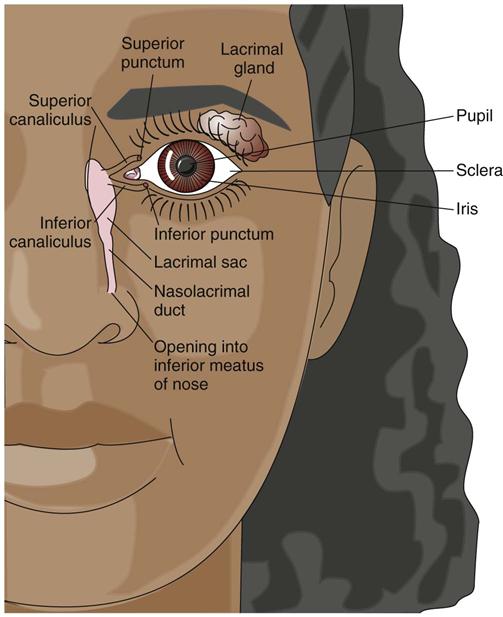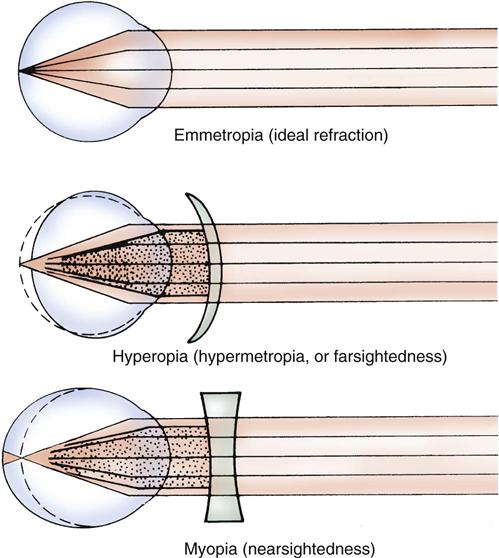M. Linda Workman
Assessment of the Eye and Vision
Learning Outcomes
Safe and Effective Care Environment
Health Promotion and Maintenance
Psychosocial Integrity
Physiological Integrity
10 Explain the relationship between intraocular pressure and eye health.
11 Use knowledge of anatomy and psychomotor skills when assessing the eye and vision.
12 Explain the eye changes associated with aging and their impact on vision.
13 Interpret the findings of visual acuity by the Snellen chart.

http://evolve.elsevier.com/Iggy/
Answer Key for NCLEX Examination Challenges and Decision-Making Challenges
Audio Glossary
Key Points
Review Questions for the NCLEX® Examination
Video Clip: Central Vision
Video Clip: External Eye
Video Clip: Pupil Responses
The eye works with the brain to cause vision. Many people consider vision to be the most important sense for sensation and cognition. It is used to assess surroundings, allow independence, warn of danger, appreciate beauty, work, play, and interact with other people.
Vision begins with the eye, where light is changed into nerve impulses. These impulses are sent to the brain, where images are fully perceived. Many systemic conditions, as well as eye problems, affect the eye and change vision temporarily or permanently. Changes in the eye and vision can provide information about the patient’s general health status and problems that might occur in self-care.
Anatomy and Physiology Review
Structure
The eyeball, a round, ball-shaped organ, is located in the front part of the eye orbit. The orbit is the bony socket of the skull that surrounds and protects the eye along with the attached muscles, nerves, vessels, and tear-producing glands.
Layers of the Eyeball
The eye has three layers, or coats (Fig. 48-1). The external layer is the sclera (the opaque tissue making up the “white” of the eye) and the transparent cornea on the front of the eye.
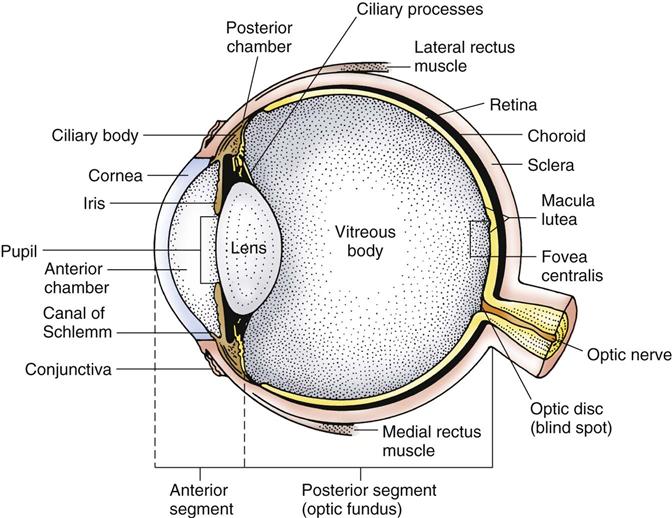
The middle layer, or uvea, is heavily pigmented and consists of the choroid, the ciliary body, and the iris. The choroid, a dark brown membrane between the sclera and the retina, lines most of the sclera. It has many blood vessels that supply nutrients to the retina.
The ciliary body connects the choroid with the iris and secretes aqueous humor. The iris is the colored portion of the external eye; its center opening is the pupil. The muscles of the iris contract and relax to control pupil size and the amount of light entering the eye.
The innermost layer is the retina, a thin, delicate structure made up of sensory photoreceptors that begin the transmission of impulses to the optic nerve. The retina contains blood vessels and two types of photoreceptors called rods and cones. The rods work at low light levels and provide peripheral vision. The cones are active at bright light levels and provide color and central vision.
The optic fundus is the area at the inside back of the eye that can be seen with an ophthalmoscope. This area contains the optic disc, a creamy pink or white depressed area where the fine nerve fibers that synapse with the photoreceptors join together to form the optic nerve and exit the eyeball. The optic disc is sometimes called the “blind spot” because it contains only nerve fibers and no photoreceptor cells. To one side of the optic disc is a small, yellowish pink area called the macula lutea. The center of the macula is the fovea centralis, where vision is the most acute.
Refractive Structures and Media
Light waves pass through these structures on the way to the retina: cornea, aqueous humor, lens, and vitreous humor. Each structure has a different density, which causes the light waves to bend (refract) and focus images on the retina. Together, these structures are the eye’s refracting media.
The cornea is the clear layer that forms the external bump on the front of the eye (see Fig. 48-1). The aqueous humor is a clear, watery fluid that fills the anterior and posterior chambers of the eye. Aqueous humor is continually produced by the ciliary processes and passes from the posterior chamber, through the pupil, and into the anterior chamber. This fluid drains through the canal of Schlemm into the blood to maintain a balanced intraocular pressure (IOP), the pressure within the eye (Fig. 48-2).
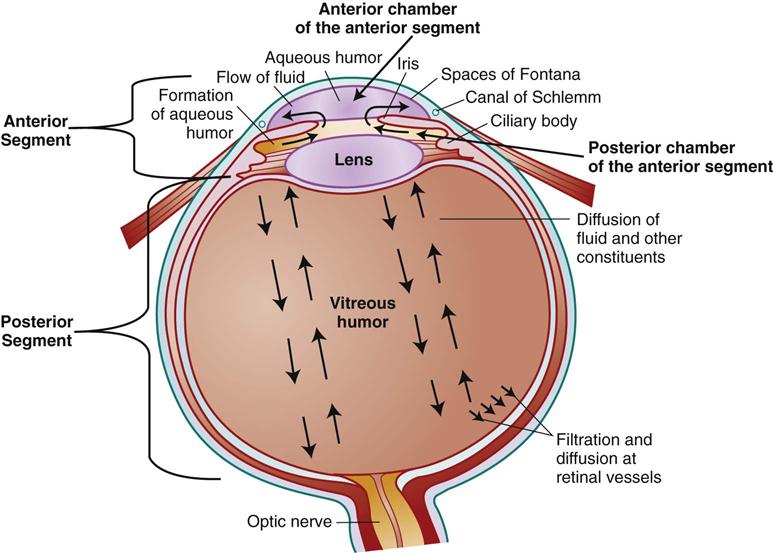
The lens is a circular, convex structure that lies behind the iris and in front of the vitreous body. It is normally transparent and bends the rays of light entering through the pupil so that they focus properly on the retina. The curve of the lens changes to focus on near or distant objects. A cataract is a lens that has lost its transparency.
The vitreous body is a clear, thick gel that fills the vitreous chamber (the space between the lens and the retina). This gel transmits light and maintains eye shape.
The eye is a hollow organ and must be kept in the shape of a ball for vision to occur. To maintain this shape, the gel in the posterior segment (vitreous humor) and the fluid in the anterior segment (aqueous humor) must be present in set amounts that apply pressure inside the eye to keep it inflated (McCance et al., 2010). This pressure is known as intraocular pressure or IOP. IOP has to be just right. If the pressure is too low, the eyeball is soft and collapses, preventing light from getting to the light-sensitive photoreceptors in the back of the eye on the retina. If the pressure becomes too high, the extra pressure compresses capillaries and nerve fibers in the eye. Pressure on retinal blood vessels prevents blood from flowing through them, and as a result the photoreceptors and nerve fibers become hypoxic. Compression of the fine nerve fibers prevents intracellular fluid flow, which also reduces nourishment to the distal portions of these thin nerve fibers. The increased intraocular pressure and resulting hypoxia of the photoreceptors and their synapsing nerve fibers is a condition called glaucoma. Continued hypoxia inside the eye result in photoreceptor necrosis and death and permanent nerve fiber damage. With extensive photoreceptor loss and nerve fiber damage, vision is lost and the person is permanently blind.
External Structures
The eyelids are thin, movable skinfolds that protect the eyes, shut out light during sleep, and keep the cornea moist. The upper eyelid is larger than the lower one. The canthus is the place where the two eyelids meet at the corner of the eye.
The conjunctivae are the mucous membranes of the eye. The palpebral conjunctiva is a thick membrane with many blood vessels that lines the undersurface of each eyelid. The thin, transparent bulbar conjunctiva covers the entire front of the eye.
Tears are produced by a small lacrimal gland, which is located in the upper outer part of each orbit (Fig. 48-3). Tears flow across the front of the eye, toward the nose, and into the inner canthus. They drain through the punctum (an opening at the nasal side of the lid edges), into the lacrimal duct and sac, and then into the nose through the nasolacrimal duct.
Muscles, Nerves, and Blood Vessels
Six voluntary muscles rotate the eye and coordinate eye movements (Fig. 48-4 and Table 48-1). Coordinated eye movements ensure that the retina of each eye receives an image at the same time so only a single image is seen.
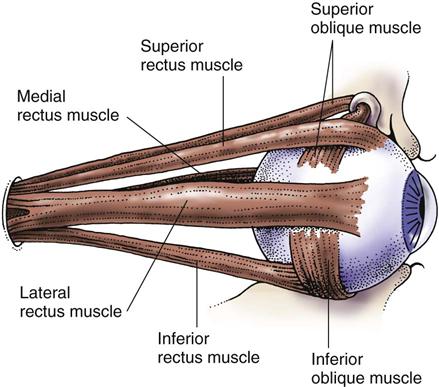
TABLE 48-1
| Superior Rectus Muscle |
| Lateral Rectus Muscle |
| Medial Rectus Muscle |
| Inferior Rectus Muscle |
| Superior Oblique Muscle |
| Inferior Oblique Muscle |
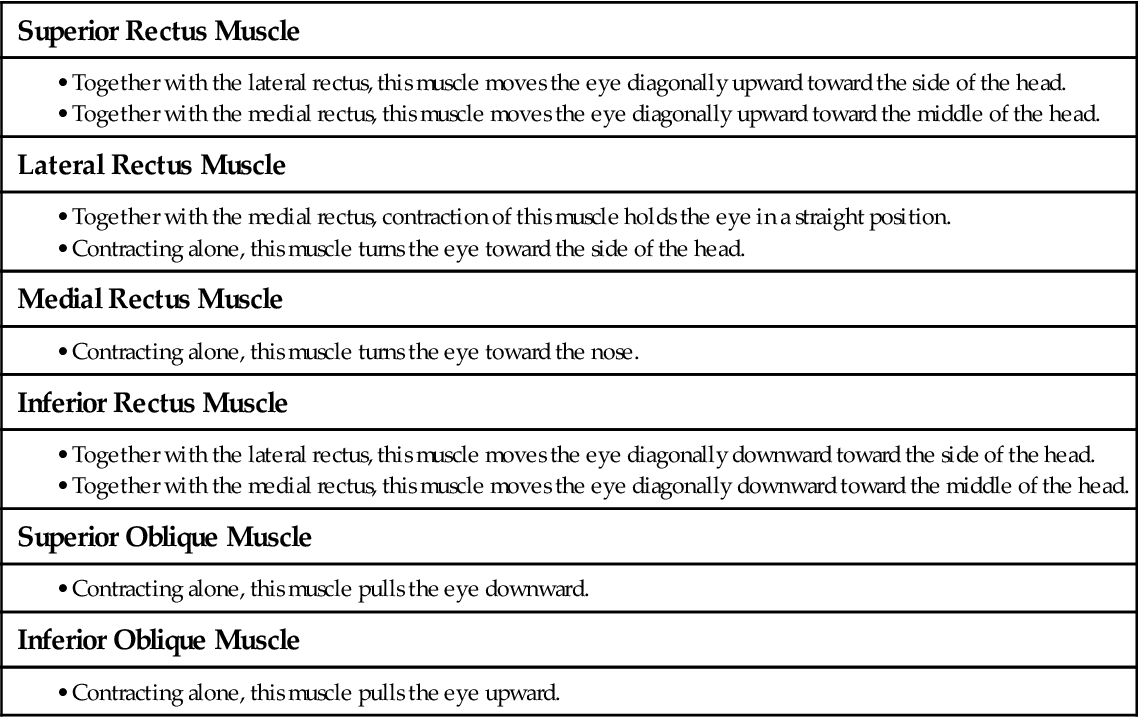
The muscles around the eye are innervated by cranial nerves (CNs) III (oculomotor), IV (trochlear), and VI (abducens). The optic nerve (CN II) is the nerve of sight, connecting the optic disc to the brain. Part of the trigeminal nerve (CN V) stimulates the blink reflex when the cornea is touched. The facial nerve (CN VII) innervates the lacrimal glands and muscles controlling lid closure.
The ophthalmic artery brings oxygenated blood to the eye and structures in the orbit. This artery branches to supply blood to the retina. The ciliary arteries supply the sclera, choroid, ciliary body, and iris. Venous drainage occurs through the two ophthalmic veins.
Function
The four eye functions that provide clear images and vision are refraction, pupillary constriction, accommodation, and convergence.
Refraction involves bending light rays from the outside world into the eye. The different curved surfaces and refractive media of the eye allow light to pass through to the retina. Each surface and media bends (refracts) light differently to focus an image on the retina. Emmetropia is the perfect refraction of the eye: with the lens at rest, light rays from a distant source (20 feet [6 m] or more) are focused into a sharp image on the retina. Fig. 48-5 shows the normal refraction of light within the eye. Images fall on the retina inverted and reversed left to right. For example, an object in the lower nasal visual field strikes the upper outer area of the retina.
Errors of refraction are common. Hyperopia (farsightedness or hypermetropia) occurs when the eye does not refract light enough. As a result, images actually fall (converge) behind the retina (see Fig. 48-5). Vision beyond 20 feet is normal, but near vision is poor. Hyperopia is corrected with a convex lens in eyeglasses or contact lenses.
Myopia (nearsightedness) occurs when the eye overbends the light and images converge in front of the retina (see Fig. 48-5). Near vision is normal, but distance vision is poor. Myopia is corrected with a biconcave lens in eyeglasses or contact lenses.
Astigmatism is a refractive error caused by unevenly curved surfaces on or in the eye, especially of the cornea. These uneven surfaces distort vision.
Pupillary constriction and dilation control the amount of light that enters the eye. If the level of light to one or both eyes is increased, both pupils constrict (become smaller). The amount of constriction depends on how much light is available and how well the retina can adapt to light changes. Pupillary constriction is called miosis, and pupillary dilation is called mydriasis (Fig. 48-6). Drugs can alter pupillary constriction.

Accommodation allows the healthy eye to focus images sharply on the retina whether the image is close to the eye or distant. The process of maintaining a clear visual image when the gaze is shifted from a distant to a near object is known as accommodation. The eye can adjust its focus by changing the curve of the lens.
Convergence is the ability to turn both eyes inward toward the nose at the same time. This action helps ensure that only a single image of close objects is seen.
Eye Changes Associated with Aging
Changes inside the eye cause visual acuity to decrease with age (Touhy & Jett, 2010). Age-related changes of the nervous system and in the eye support structures also reduce visual function (Chart 48-1).
Structural changes occur with aging, including decreased eye muscle tone that reduces the ability to keep gaze focused on a single object. The lower eyelid may relax and fall away from the eye (ectropion), leading to dry-eye symptoms.
Arcus senilis, an opaque, bluish white ring within the outer edge of the cornea, is caused by fat deposits (Fig. 48-7). Although very common, this change does not affect vision.

The clarity and shape of the cornea change with age. After age 65 years, the cornea flattens and the curve of its surface becomes irregular. This change causes or worsens astigmatism and blurs vision.
Fatty deposits cause the sclera to develop a yellowish tinge. A bluish color may be seen as the sclera thins. With age, the iris has less ability to dilate, which leads to difficulty in adapting to dark environments. Older adults may need additional light for reading and other “close up” work and to avoid tripping over objects.
Functional changes also occur with aging. The lens yellows with aging, reducing the ability of the eye to transmit and focus light. The aging lens hardens, shrinks, and loses elasticity. As the lens loses elasticity, the eye reduces accommodation. The near point of vision (the closest distance at which the eye can see an object clearly) increases. Near objects, especially reading material, must be placed farther from the eye to be seen clearly. This age-related change is called presbyopia. The far point (farthest point at which an object can be distinguished) decreases. Together these changes narrow the visual field of an older adult.
As a person ages, general color perception decreases, especially for green, blue, and violet. More light is needed to stimulate the photoreceptors. Intraocular pressure (IOP) is slightly higher in older adults.
Health Promotion and Maintenance
Vision is important to everyday function and quality of life. Many vision and eye problems can be avoided, and others can be corrected or managed if discovered early. Teach all people about eye protection methods, adequate nutrition, and the importance of regular eye examinations.
The risks for cataract formation and for cancer of the eye (ocular melanoma) increase with exposure to ultraviolet (UV) light. Teach people to protect the eyes by using sunglasses that filter UV light whenever they are outdoors. Also explain that UV protection should be used in tanning salons and in work environments that have UV exposure.
Vision can be affected by injury, and eye injury also increases the risk for both cataract formation and glaucoma. Urge all people to wear eye and head protection during work in occupations that involve particulate matter, fluid or blood spatter, high temperatures, or sparks. Eye and head protection should be worn during participation in sports, such as baseball, or any activity that increases the risk for the eye being hit by objects in motion. Teach people to avoid rubbing the eyes because excessive eye rubbing can traumatize the delicate outer eye surfaces.
Eye infections can lead to vision loss. Although the eye surface is not sterile, the sclera and cornea have no separate blood supply and thus are at risk for infection because the immunities in the blood do not reach these structures. Teach everyone to wash their hands before touching the eye or eyelid. Teach people who use eyedrops about the proper technique to use these drugs (Chart 48-2) and to not share eyedrops with others. If an eye has a discharge, teach the patient to use a separate eyedrop bottle for this eye and to wash the unaffected eye before washing the affected eye.
